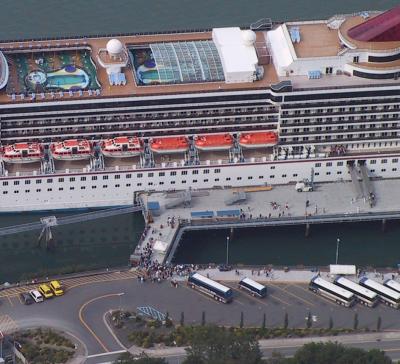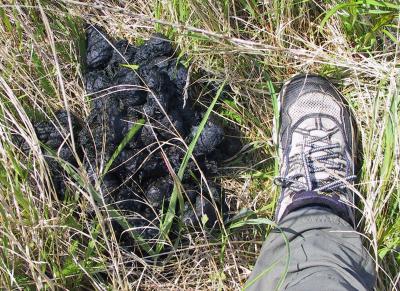I am continually astonished at what some people interpret and accept as a natural experience. When I visited Juneau in southwest Alaska this year, I hiked up into the neighborhood of Mount Gastineau. Some of you may know there's now a tram that allows you to skip a good part of the hiking and just have the hilltop view without any effort, but I like hiking too much to ride it.
Near the tram building on top are some viewing platforms that allow you to view the city of Juneau and surrounding countryside without having to sit on a rock. Above this point are some nice trails leading into some very pretty terrain higher up. This year I got an early start, rode my bike from the marina to the trailhead in town, climbed up to the top of the tram line, then continued up to the higher terrain. I managed to get some nice pictures of birds and marmots and a very nice view of town. And why was this true — why did I get nice pictures of these shy creatures? It's simple — I was the only person up there at that hour.
The fact that most people — even Alaskans, not just the tourists — can't be bothered to take a hike on a well-developed footpath wouldn't be worthy of comment except that Americans are incredibly overweight. According to the
American Obesity Association, almost two thirds of Americans are overweight, and over 30% are obese. Just to simplify the issue, here are my personal definitions — "overweight" means it's time to take a walk every day, and "obese" means it's almost too late — the walk may kill you, but not walking surely will.
Obesity is becoming an issue even among American children, about 15% of whom are overweight. This is especially troubling because lifelong body-weight and behavior patterns become established in this age group, patterns it can be very difficult to break later.
Tourists debarking love boat
How many of these people think the problem is going to go away without any effort on their part? I honestly don't know. But I do know this — people appear to be doing all they can to avoid exercise, and the ingenuity of this inactivity is, if anything, on the increase. As I hiked in the foothills of Mount Gastineau, looking down on the town of Juneau, a love boat (translation: floating hotel) showed up at the Juneau town docks and the tourists debarked to ... get some exercise? Not on your life, or, more to the point, theirs. They walked the shortest practical distance from the boat gangway to the nearest tour bus, and sat down again (see picture at right).
If this isn't enough, the Alaska tour boat operators are now clamoring for permissison to allow their clients to travel around on Segway personal transporters, thus removing the last vestige of anything that could remotely be interpreted as exercise. You see, some tourist experiences, like a visit to a historical district, aren't practical to drive through in a tour bus (streets too narrow), or the experience in question involves actually entering a building or two, while (perish the thought)
on foot. So, someone came up with the idea of putting the tourists on these new, hi-tech two-wheeled carts, which, very instructively, were designed by someone justly famous for his innovative wheelchair designs (Dean Kamen).
I only know this Segway story because the city of Anchorage doesn't presently allow the transporters on city sidewalks, which caused the city council to balk at the demands of the tour boat operators, which caused the latter to raise a hue and cry on behalf of their clients in the newspapers. As to the final outcome, stay tuned — Alaska will do nearly anything to encourage tourism.
And don't let this prose confuse you. I like hiking and I hike a lot, but I am actually rather lazy compared to my earlier years. An example? There I was, sitting high above Juneau, marveling at the sight of the tour boat clients emerging from the boat and quickly ducking into tour buses. I laughed and took the picture on this page, feeling oh, so superior. Just then two hikers marched by, carrying full sets of telemark ski equipment. They intended to hike up to the top of Mount Gastineau or Roberts and then ski down as far as they could before hiking back into town. This was June, a time of rather high avalanche risk, especially in the steep terrain east of Juneau. I was quickly put in my place.
In a hypothetical truly civilized society, when people tried to acquire a Segway or some other exercise-avoidance gadget, some benevolent official would decide whether they should have it. If someone weighed too much, the official would say, "Sorry! You need the exercise — no Segway for you!"
I find myself thinking this way with some regularity lately — "If this were a civilized, benevolent society, then" etc. etc.. This is obviously rather silly, since societies are not designed to be benevolent or civilized, but only to reflect the values of the individual members. Therefore on this reasoning societies can only be as civilized as the least civilized participant, in the same way that a bank queue can only move as fast as the person in front.
Bear scat on the trail ... and a big bear it was
This leads into a theory of mine (I almost said "segue" but it seems that word's been taken over), one bearing on the behavior of hiking groups. If I am walking on a trail and I encounter people traveling in the same direction, I have a theory about whether I'll pass them up. It goes like this:
- If another person is walking alone, I figure my chances of passing him up are even, probability 1/2, assuming that I walk at an average pace.
- But if it is a group, not an individual, the probability of my passing them up is much better. Here's why:
- A group of people walking together, in order to stay united as a group, cannot exceeed the walking pace of the slowest member. Therefore either:
- The entire group's pace is set by the slowest member, or
- The group splits apart.
- It is reasonable to assume about a group that it represents a typical collection of walking paces, some faster, some slower than average.
- Because it is moving as a group, its walking speed is by definition being set by the pace of the slowest member.
- Therefore the probability that a typical individual hiker will pass a typical group is much greater than chance.
- So, while walking along a trail, if I see another person or hear footsteps, I don't draw any conclusions right away. But if I hear voices along with the footsteps, I assume the chances are good that I'll be passing the group that belongs to the voices. This observation is usually borne out by events, but in this case the theory is more interesting than the evidence for it.
Conclusion? Whatever advantages society confers on its members, there is one underlying, inescapable principle: no individual can move ahead of the group (interpret that however you want) without also breaking away entirely and leaving the group behind. And, just as with hikers on a trail, the group's overall mental state is very likely to be that of its slowest members.


 Share This Page
Share This Page

 Share This Page
Share This Page





 Share This Page
Share This Page